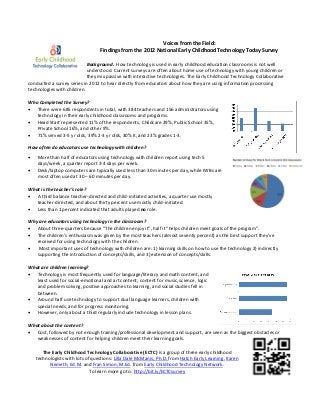
Voices from the Field: Findings from the 2012 National Early Childhood Technology Today Survey
- 1. Voices from the Field: Findings from the 2012 National Early Childhood Technology Today Survey Background. How technology is used in early childhood education classrooms is not well understood. Current surveys are often about home use of technology with young children or they mix passive with interactive technologies. The Early Childhood Technology Collaborative conducted a survey series in 2012 to hear directly from educators about how they are using information processing technologies with children. Who Completed the Survey? There were 685 respondents in total, with 384 teachers and 156 administrators using technology in their early childhood classrooms and programs. Head Start represented 11% of the respondents, Childcare 29%, Public School 35%, Private School 16%, and other 9%. 71% served 3-5 yr olds, 39% 2-3 yr olds, 30% K, and 23% grades 1-3. How often do educators use technology with children? More than half of educators using technology with children report using tech 5 days/week, a quarter report 3-4 days per week. Desk/laptop computers are typically used less than 30 minutes per day, while IWBs are most often used at 30 – 60 minutes per day. What is the teacher’s role? A third balance teacher-directed and child-initiated activities, a quarter use mostly teacher-directed, and about thirty percent use mostly child-initiated. Less than 1 percent indicated that adults played no role. Why are educators using technology in the classroom? About three-quarters because “The children enjoy it”, half it “helps children meet goals of the program”. The children’s enthusiasm was given by the most teachers (almost seventy percent) as the best support they’ve received for using technology with the children. Most important uses of technology with children are: 1) learning skills on how to use the technology 2) indirectly supporting the introduction of concepts/skills, and 3) extension of concepts/skills. What are children learning? Technology is most frequently used for language/literacy and math content, and least used for social-emotional and art content; content for music, science, logic and problem solving, positive approaches to learning, and social studies fell in between. Around half use technology to support dual language learners, children with special needs, and for progress monitoring. However, only about a third regularly include technology in lesson plans. What about the content? Cost, followed by not enough training/professional development and support, are seen as the biggest obstacles or weaknesses of content for helping children meet their learning goals. The Early Childhood Technology Collaborative (ECTC) is a group of three early childhood technologists with lots of questions: Lilla Dale McManis, Ph.D. from Hatch Early Learning, Karen Nemeth, Ed.M. and Fran Simon, M.Ed. from Early Childhood Technology Network. To learn more go to: http://bit.ly/ECTCsurvey
